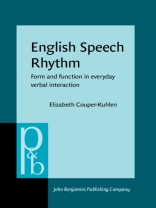This monograph reconsiders the question of speech isochrony, the regular recurrence of (stressed) syllables in time, from an empirical point of view. It proposes a methodology for discovering isochrony auditorily in speech and for verifying it instrumentally in the acoustic laboratory. In a small-scale study of an English conversational extract, the gestalt-like rhythmic structures which isochrony creates are shown to have a hierarchical organization. Then in a large-scale study of a corpus of British and American radio phone-in programs and family table conversations, the function of speech rhythm at turn transitions is investigated. It is argued that speech rhythm serves as a metric for the timing of turn transitions in casual English conversation. The articular rhythmic configuration of a transition can be said to contextualize the next turn as, generally speaking, affiliative or disaffiliative with the prior turn. The empirical investigation suggests that speech rhythm patterns at turn transitions in everyday English conversation are not random occurrences or the result of a social-psychological adaptation process but are contextualization cues which figure systematically in the creation and interpretation of linguistic meaning in communication.
Elizabeth (University of Konstanz) Couper-Kuhlen
English Speech Rhythm [PDF ebook]
Form and function in everyday verbal interaction
English Speech Rhythm [PDF ebook]
Form and function in everyday verbal interaction
Buy this ebook and get 1 more FREE!
Format PDF ● Pages 346 ● ISBN 9789027285836 ● Publisher John Benjamins Publishing Company ● Published 1993 ● Downloadable 3 times ● Currency EUR ● ID 4223487 ● Copy protection Adobe DRM
Requires a DRM capable ebook reader












